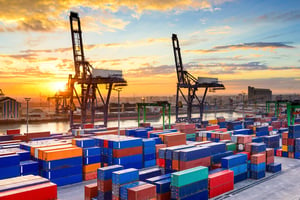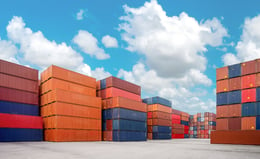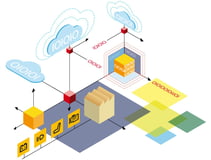Use Cases for Real-Time Supply Chain Visibility
Nicole Wanichko - March 04, 2021

Many companies perceive themselves as lacking in complete supply chain visibility, listing it as their most significant operational challenge. Lack of visibility is a significant issue for any organization, especially those operating in supply chain management. Before we lay out everyday use cases for supply chain visibility, we'll touch upon what it is and why your organization needs to have it.
 So, what is it? Supply chain visibility is the ability to locate a specific product's position as it moves through the supply chain, which means that you have full sight and awareness of your product's status from start to finish, in real-time. This is extremely helpful for various reasons, but it primarily allows you access to every step of the supply chain. This ensures that there will be no surprised such as late deliveries, lost products, or even damaged goods. You can obtain this visibility through the utilization of IoT devices and cloud monitoring tools. Combining these technologies will allow you full monitorization through GPS tracking, quality alerts, and notification of possible disruptions. With these tools in your pocket, you will be aware of disruptions immediately, giving you as much time as possible to resolve them and get back to work. Additionally, with so much data available, this visibility will improve planning, allowing you to access accurate and timely information whenever necessary so that management, staff, and customers will always be in the loop.
So, what is it? Supply chain visibility is the ability to locate a specific product's position as it moves through the supply chain, which means that you have full sight and awareness of your product's status from start to finish, in real-time. This is extremely helpful for various reasons, but it primarily allows you access to every step of the supply chain. This ensures that there will be no surprised such as late deliveries, lost products, or even damaged goods. You can obtain this visibility through the utilization of IoT devices and cloud monitoring tools. Combining these technologies will allow you full monitorization through GPS tracking, quality alerts, and notification of possible disruptions. With these tools in your pocket, you will be aware of disruptions immediately, giving you as much time as possible to resolve them and get back to work. Additionally, with so much data available, this visibility will improve planning, allowing you to access accurate and timely information whenever necessary so that management, staff, and customers will always be in the loop.
Real-Time Information
One of the most vital aspects of supply chain visibility is the real-time factor. Receiving information in real-time is growing in importance as we continue to live in a world that values instant gratification. Real-time information significantly increases efficiency, allowing your supply chain to become more agile and responsive than ever before. Without delays in communication or data analysis, you will be aware of every movement in the supply chain as it happens. While we speak in a broad sense, we'll get into some examples of how real-time information works within specific aspects of the supply chain, detailed further in our blog 4 Surprising Uses for Real-time Information in the Supply Chain.
In terms of inventory management, real-time information is vital. If there are any changes to your inventory, this information should be relayed immediately to ensure that your company receives and delivers the determined amount of product. This information will also allow you to better prepare your storage spaces and delivery services, so you know exactly how much space each shipment requires. Not only will this save you a great deal of money, but it will help you plan for future inventory and freight planning. Beyond inventory updates, real-time information also can provide you with event-based early warnings. This will notify you of possible weather-caused delays, late deliveries, rerouted shipments, and other disrupting events that could catch you off-guard. Once warned, you have the opportunity to adjust in advance to minimize any consequences. This allows you quickly react and continue to maximize value while handling disruptions.
The earlier you receive vital information, the better you can plan your reaction. Creating a more responsive production environment will open countless doors for your organization to improve and integrate. With accurate and efficient real-time information, you will have a more cohesive relationship between sales and operations, allowing you to create and fulfill more successful long-term goals without unexpected disruptions. Improved adaptability from real-time information can even lead to improved customer service. With real-time updates about the product, shipping, and delivery status, you can relay this information to your customers, putting them at ease knowing exactly where their item is at any time. Additionally, in giving your customers access to this information, there will be less unnecessary contact made regarding an order's status or location – they will already have that information! This will elevate your customers’ trust in you, developing a strong sense of satisfaction and loyalty.
Use Cases
Now that you have a better understanding of real-time supply chain visibility and its significance, we will dive into some use cases to illustrate practical approaches to achieving this visibility.
- Exception handling: As supply chain visibility provides manufacturers with tracking on products' physical location, it allows them to control and route the supply chain as it moves. Through every step of the supply chain, manufacturers and retailers will have the ability to track and monitor products to ensure efficient shipping between destinations and timely arrival. While it may seem as though this does not drastically improve supply chain logistics, this allows you to quickly realign operations when unforeseen events occur and understand precisely where materials are within the process.
- Vehicle Logistics: In terms of the automotive industry, supply chain visibility often goes overlooked, but it does not have to be. There is usually a blind spot between a finished vehicle leaving a manufacturer and arriving to a customer where no involved parties have the vehicle's status – not even knowing whether it is on land or sea. Even with some current systems, there is typically a 5% deviation in the system-shown location of the vehicle and its actual location, causing confusion and frustration. With real-time supply chain visibility, you will have the vehicle's exact location, allowing for concrete calculations of arrival time.
- Stop Shipment: Stop shipments notifications are just that – alerts sent out to stop automotive productions in case of manufacturing errors. These allow manufacturers to stop the production process before faulty cars are completely or sent out and then repair any mistakes. This can affect anywhere from one vehicle to thousands, so it is vital to call the stop notification as quickly as possible to avoid losing any more time or money. Most current stop shipment procedures involve manually running through lists and emails to stop movement, but often some cars leave the facility before the notification is received. With real-time supply chain visibility, you can prevent these production mistakes altogether, but if not completely prevent them - resolve them with incredible speed. Once alerted, all faulty vehicles are quickly identified, updating inventory, and preventing shipment.
Real-time visibility is key to running an efficient supply chain, and most companies are achieving it through digitization. Digitization is a broad term, but essentially, it incorporates AI and similar cloud services into your supply chain, allowing you the real-time visibility we have discussed. This will provide you with constant tracking and monitoring, accurate data analysis and calculations, in addition to alerts warning you of any possible interferences. In utilizing these services, your organization will have full-time monitoring access to every step of the supply chain, allowing you to adjust and optimize operations, prevent and respond to disruptions, and satisfy customers – while saving time and money.
LATEST POSTS
- Understand Circular Economy in The Manufacturing Industry
- How Can Industry 4.0 IT Integration Be Achieved Smoothly?
- The Significance of Order Sequencing in Discrete Manufacturing
- How to improve your Supply Chain Management: The Power of Control Towers
- Optimizing Human Resource Scheduling in Manufacturing: A Technological Approach



